This salmon buddha bowl is the perfect weeknight main course or quick meal prep. Ready in 20 minutes, this ridiculously healthy bowl is a balanced meal packed with multiple fresh vegetables and protein rich salmon!

Want to save this recipe?
Enter your email below & we'll send it straight to your inbox. Plus you'll get fun new recipes from us every week!
You have probably heard of a buddha bowl. Maybe at a hip cafe in the city or on an Applebee’s menu. They gained popularity first among the vegan community and now are enjoyed by vegan and non-vegans alike. I mean, have you seen that photo above? Who wouldn’t love a bowl packed with rice, delicious produce, and protein?
Interestingly, buddha bowls lack a formal definition and origin. According to Urban Dictionary, a buddha bowl is “a bowl which is packed so full that it has a rounded "belly" appearance on the top much like the belly of a buddha”. Other ideas are that buddha bowls resemble how a buddha eats by walking around and accepting small portions of food from (source). Overall, the general consensus is that a buddha bowl is an abundant and happy bowl.
As I mentioned, these bowls are often found in a vegan form so why make a salmon one? Because it’s delicious, that’s why. I, quite literally, have been eating this for lunch or dinner two to three times every week.
This recipe uses a sweet, spicy, Asian-inspired sauce with ginger, soy sauce, honey, ponzu, and chili paste. When poured over the salmon and baked, it becomes wonderfully sticky and locks in the moisture for salmon filets that just melt in your mouth.
Jump to:
Ingredients and Substitutions
Core Ingredients:
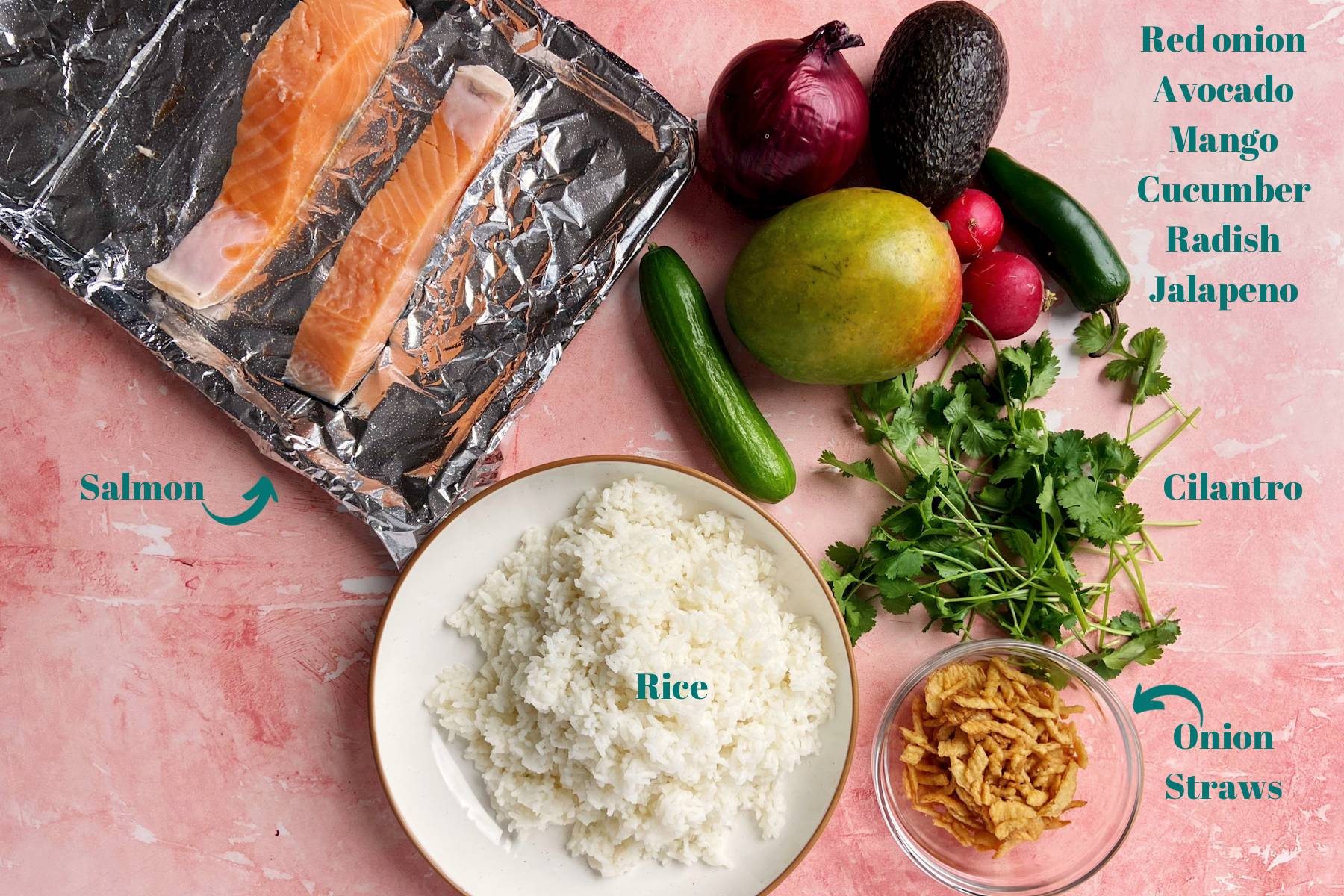
Sauce Ingredients:
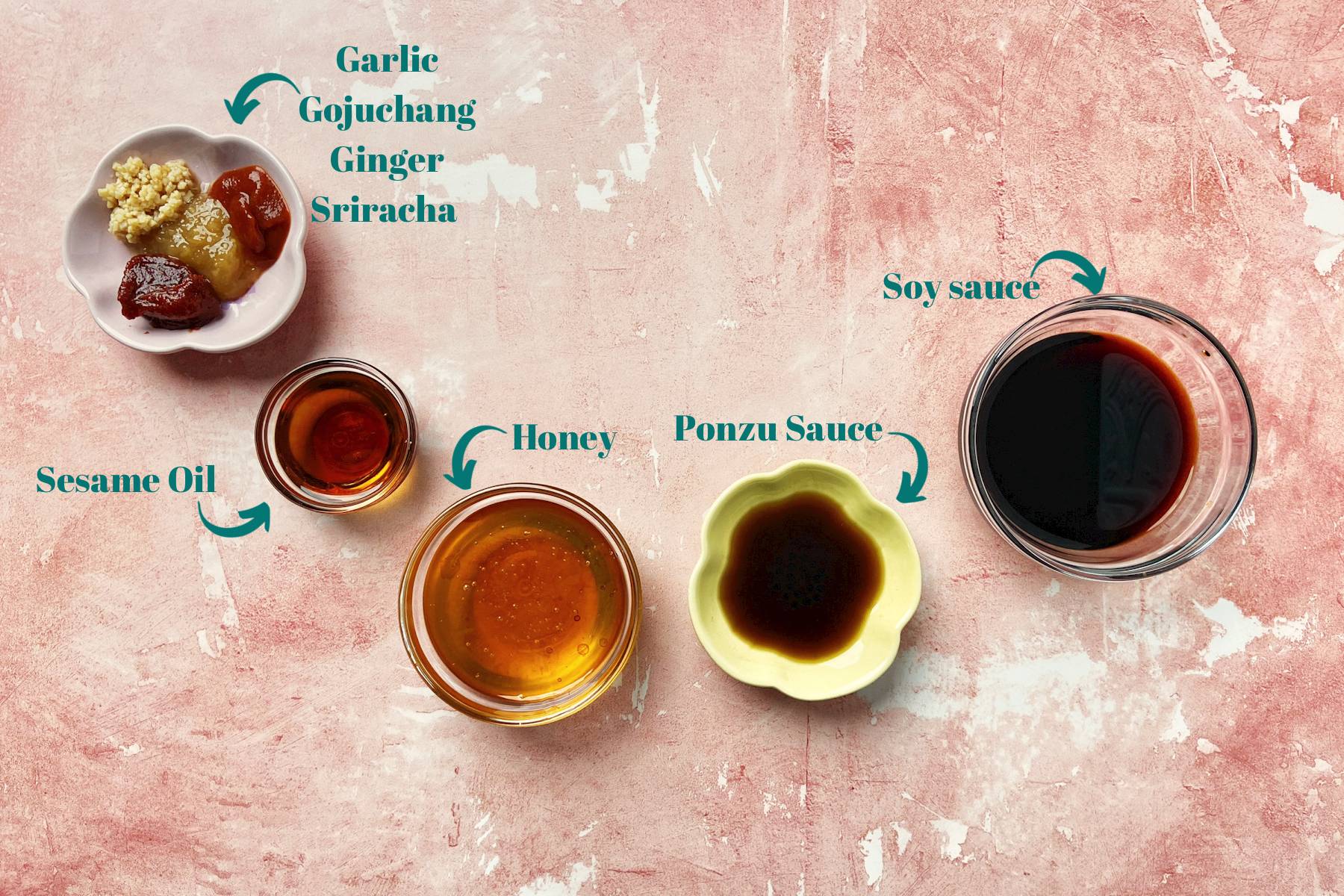
All substitution options are a 1:1 substitution unless noted otherwise.
Cucumber, Red Onion, Avocado, Radish: These fresh vegetables add color, texture, and nutrients to this bowl. We love this combination because the fresh cucumbers and radish add crunch while the red onion adds a tang, and the creamy avocado helps cool the jalapeno (listed below).
Substitutions: Any of your favorite vegetables can be used! Some other great options are carrots, edamame, red cabbage, bell peppers, sweet potatoes, ginger, seaweed, green onion, or scallions. You can also omit any you do not like or do not have.
Jalapeno: This adds additional spice to the dish. Just be careful to remove the seeds if you do not want it too spicy.
Substitutions: Any hot pepper can be used. Fresno chilis and serranos are the most similar, spice-wise, to jalapenos. These can also be left out if you don’t want too much spice. Check out our post here all about substitutions for jalapenos.
Mango: Mango adds a sweetness that also helps counter the spiciness of the jalapeno. And, who doesn’t love sweet and spicy?
Substitutions: Canned, fresh, or frozen pineapple or frozen mangoes (defrosted) can be used.
Salmon: Salmon is the main protein of this dish. This lean protein is packed with nutrients and healthy fats making it an ideal protein source that is quick to cook. It honestly takes longer to thaw from frozen than to cook.
Substitutions: Chicken, tofu, chickpeas, or white fish could be used in place of salmon fillets. Cooking time will vary greatly with chicken and tofu and chickpeas can simply be marinated in the sauce.
Cilantro: Cilantro is a wonderful topping to this bowl and gives it an earthy bite.
Substitutions: Cilantro can be replaced with parsley or left out. This is not a make-or-break ingredient.
Onion Straws: Onion straws are CRITICAL to this recipe. They provide a final crunch, butteriness, and salty flavor.
Substitutions: Fried jalapenos, bread crumbs, sesame seeds, or crushed potato chips can be used.
White Rice: Ah, the base. Rice is how this bowl gets its hardiness. It is also a great vessel for the sauce and fresh veggies and fruit. We use jasmine white rice or microwaved sticky rice. We highly recommend instant rice for an easy lunch or dinner.
Substitutions: Any rice or grain could be used - quinoa, brown rice, or lentils. A leafy green or cauliflower rice could also be used if you're eating low-carb.
Ponzu Sauce: Ponzu sauce is a citrus dipping sauce and gives our sauce its acidity and a bit of saltiness.
Substitutions: You can make your own using a recipe like this one! You can also substitute lemon juice, lime juice, or orange juice.
Honey: Honey provides the sweetness for this sweet and spicy sauce.
Substitutions: White sugar, maple syrup, agave, or brown sugar can be used.
Soy Sauce: Soy sauce adds saltiness (a lot of saltiness so measure carefully) and umami. It is derived from soybeans that have been fermented and recipes are often passed down from generation to generation when made from scratch.
Substitutions: Coconut aminos, if gluten-free, or any soy sauce can be used. Some soy sauces are gluten-free but typically are not because wheat is one of the main ingredients. A soy-based sauce, such as Ponzu or Soyaki (from Trader Joe’s) can also be used.
Rice Vinegar: Rice wine vinegar adds a bite or tang to the sauce.
Substitutions: White vinegar can be used. Apple cider vinegar may be able to be used but it has a much stronger flavor that I do not feel would go well with this dish.
Minced Ginger: Ginger is an essential ingredient in many Asian cultures and in this sauce. It adds a unique brightness through the flavor of ginger.
Substitutions: Diced ginger or ginger juice can be used. Fresh ginger can also be finely chopped and used.
Sriracha and Gojuchang: These add spice to the sauce. They are both fermented pastes and you could probably get away with just one of the two, but I love the depth of flavor. Gojuchang is made from a mix of chili powders and is of Korean origin while Sriracha is made from a specific chili and of Thai origin.
Substitutions: Any spicy sauce or paste can be used (not buffalo). ½ tablespoon of Chili powder or ½ teaspoon of cayenne could also be used.
Minced Garlic: Garlic is purely for the wonderful flavor.
Substitutions: Any form of garlic can be used. If using garlic powder, use 1 teaspoon for every 1 tablespoon of minced garlic.
Sesame Oil: Sesame Oil adds so much flavor to this sauce. It takes it from good to great with the nutty and toasted flavor. Because it is an oil, it also helps to protect the salmon while cooking.
Substitutions: avocado oil or olive oil can be used, but it will not have the same nuttiness. Regular or toasted sesame oil is also fine.
How to Make This - Step by Step
Step one: Preheat the oven to 375 degrees and line a sheet pan with aluminum foil. Defrost the salmon if needed.
Step two: Make the sauce by combining all the sauce ingredients in a mason jar or small bowl and mixing until well combined.
Step three: Place the salmon on the baking sheet or sheet pan and glaze the salmon by pouring half of the sauce over the salmon. Reserve the other half of the sauce for topping on the bowls. Bake for 15 to 20 minutes until a thermometer reads 145 degrees.
Step four: While the salmon cooks, chop all the vegetables and toppings and make the rice. Make rice as directed on the package. Cut the cucumber, red onion, jalapeno, and radishes into thin slices. Dice the avocado and mango. Rough chop the cilantro and onion straws.
Step five: Assemble your bowls by placing half of the rice on the bottom or each bowl and then half of each vegetable and fruit around the rice in each bowl.
Step six: Remove the salmon from the oven and place 1 filet of cooked salmon on top of the rice in each bowl. Top each with half of the remaining sauce.
Step seven: Finish the bowls with a little bit of cilantro and onion straws and enjoy!
Watch How to Make This - Step by Step
Quick Facts and Common Questions
How long does this keep?
This bowl, assembled, will keep for 2 days in the refrigerator. If ingredients are stored separately, everything but the salmon will keep for up to 5 days.
How do I store this if I have leftovers?
We recommend storing these bowl meals assembled but without the onion straws if you plan to eat them in the next day or two. Storing them with the sauce and vegetables keeps the rice from drying out but also means the onion straws should be kept separate to avoid them becoming soggy.
How do I reheat this?
To reheat, remove the piece of salmon from the bowl and heat it in the microwave for 1 -2 minutes and then return it to the bowl. Top with onion straws and enjoy! If you do not think you will eat the bowl in two days, it is best to store all the ingredients separately in the fridge, or at least the salmon since that will not last more than two days.
Where do I buy ponzu and gojuchang?
These can typically be found in the Asian section of the grocery store or at an Asian market. You can also get them online here: Ponzu and Gojuchang.
Can this be made vegan or gluten-free?
Sure can! To make this gluten-free, use certified gluten-free rice and soy sauce, or use coconut aminos in place of the soy sauce. Also, omit the onion straws or replace them with sesame seeds. To make this bowl vegan, replace the honey with agave or maple syrup and use tofu or chickpeas in place of salmon.
What is a Buddha bowl?
I kind of went over this above, but Buddha bowls lack a formal definition. It's generally accepted as any warm bowl with grain, vegetables, and protein. According to Urban Dictionary, a Buddha bowl is “a bowl which is packed so full that it has a rounded "belly" appearance on the top much like the belly of a buddha”.
What is a good size bowl for a Buddha bowl?
Good question! Buddha bowls are best served in wide shallow bowls. This is because it allows you to reach all the ingredients or mix them all to ensure you have a bite of everything together.
How do you eat a Buddha bowl?
You can eat it pretty much any way, but I recommend cutting up the salmon and mixing everything together to get a bite of everything at once. Typically I eat this bowl so fast that I forget how I ate it… You could also top with a little sriracha mayo for an additional creaminess!
Fun Fact!
Soy Sauce is rumored to be traced back to a sauce called “jan” in ancient China. This sauce referred to anything that began from picking raw materials in salt to preserving them. (Source)
Try these other healthy recipes!
Parmesan Crusted Baked Walleye
Recipe
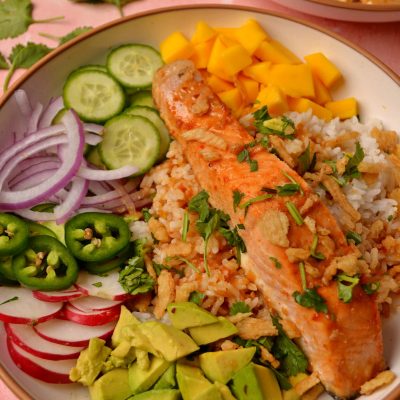
Salmon Buddha Bowl
Ingredients
Main Bowl Ingredients
- 2 salmon fillets (thawed)
- 1 cucumber (mini)
- ⅛ red onion
- 1 mango
- 2 radishes
- 1 jalapeno
- 1 avocado
- 2 tablespoon onion straws
- ⅔ cup jasmine rice (cooked)
- 2 tablespoon cilantro
Sauce Ingredients
- 1 tablespoon Ponzu
- ¼ cup soy sauce
- 1 tablespoon rice vinegar
- 2 tablespoon sesame oil
- ½ teaspoon ginger (minced)
- 1 tablespoon honey
- 1 tablespoon sriracha
- 1 tablespoon gojuchang
- 1 teaspoon garlic (minced)
Before you start!
If you make this recipe, please take a moment to leave us a review. We love to hear from you!
Instructions
- Preheat the oven to 375. Line a baking tray with foil and thaw salmon if needed. Make the rice as directed (we love microwave sticky rice!)
- Make the sauce by combining all the sauce ingredients in a jar or bowl and mixing until well combined.
- Place the salmon pieces on the tray and pour half of the sauce on them. Bake for 15-20 minutes.
- While the salmon bakes, prep the vegetables and topping.
- Thinly slice the cucumber, red onion, jalapeno, and radishes. Dice the mangoes and avocado. Rough chop the onion straws and cilantro.
- Place a ½ cup (or half of the microwave container) of rice in each bowl. Add mangoes, jalapenos, avocados, cucumbers, radishes, and red onions. Remove salmon from oven.
- Lay salmon on top of the bowl, drizzle remaining sauce over, and top with crunchy onion straws and cilantro. Enjoy!
Video
Notes
Looking for more information?
Additional substitution information can be found above in the substitution section of this post.
Nutrition Disclaimer
Nutritional information is an estimate and for informational purposes only.

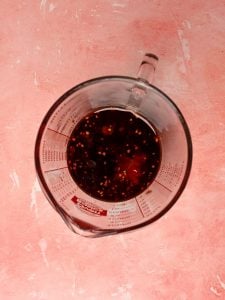
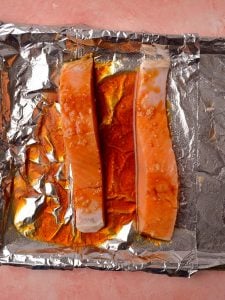
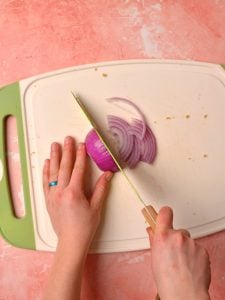
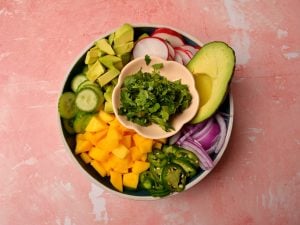

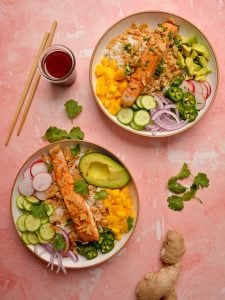
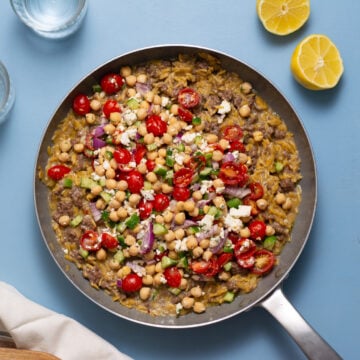
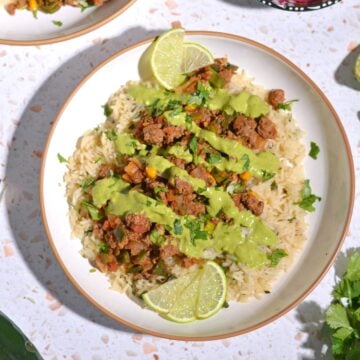
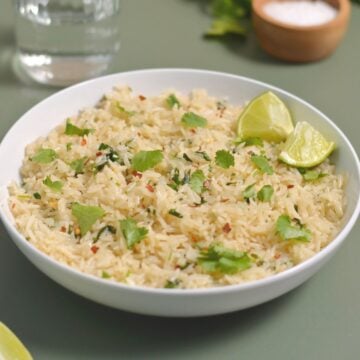
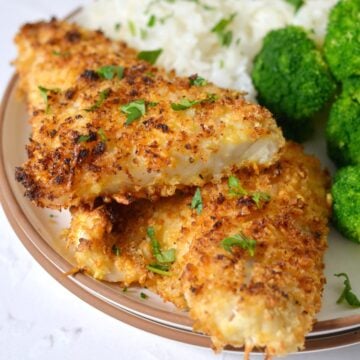
This looks so good, can't wait to try it!
Thank you, we appreciate it!
Love this!
One of my favs!!😃 such a great combination of flavours and textures.
This is awesome, tastes amazing for a quick dish and easy to make as a college kid.
Really good!